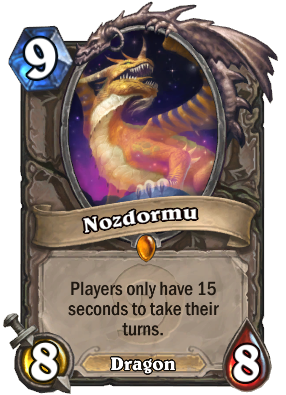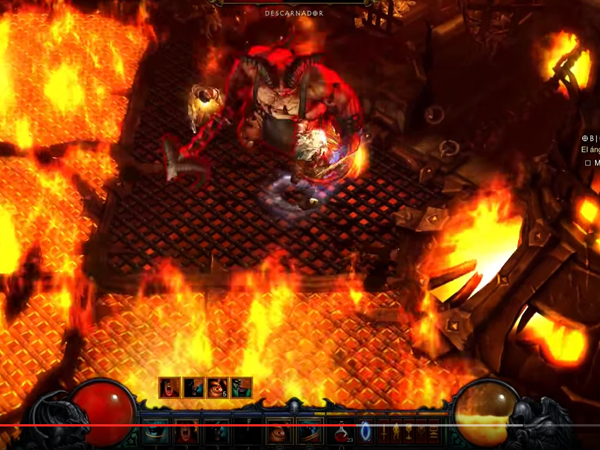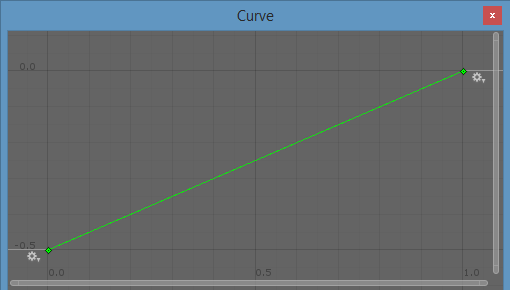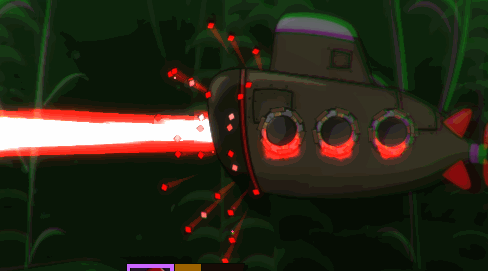-

Elements of a Good Boss Fight, Part 1: Anticipation
After jamming out the first 15 bosses in Fingeance, I feel like I’ve learned a few things, and I thought I’d share. The first topic is anticipation. We’ll see how the first moments of a boss fight can help players understand the battle to come. We’ll also look at how unique and crazy boss attacks can raise the stakes, not just for this fight, but for the rest of the game, also if you’re interested in a good game, you could use also a big screen for this and you can get home theater atlanta, ga trusted installers to create this setup for you. I hope you’ll like it.
Anticipation in Boss Design
Let’s start with a non-sequitur.
Nozdormu. The buggiest card in Hearthstone. The father of numerous glitchy strategies that lock opponents out of the game. The target of 22% of all Hearthstone hotfixes. Blizzard has done so much work — extending players’ turns in certain circumstances and changes to how server vs. client time are calculated — all to support that one weird ability: “Players only have 15 seconds to take their turns.”
Last year, Ben Brode evaluated the card in a video. Given all of the toil in making this one card, it might surprise you that Brode says “Nozdormu is a good card.” Why? “Because it blows your mind. It makes you think… anything can happen in this game.” Taken at face value, this quote implies tremendous value in that sense of possibility. For that feeling that anything can happen, Hearthstone developers allowed Nozdormu to exist, to ruin countless games on the ladder, and to sap time and talent away from developing new cards.
Why? Why was so much effort lavished on this one card, a card that has never even seen tournament play, except by accident? My theory is this: player anticipation is always cheaper, and often better, than actual content.
When we make bosses, we can tap into this power. In these unique enemies, we have a chance to blow minds and break rules. We have a moment where, if we play our cards right, we can make people truly believe in our game and keep playing to see what happens next.
There’s undeniable appeal in tapping into players’ imagination. For one thing, it’s cheap. The bossmaker’s art is a microcosm of game development itself: each boss demands AI, a unique battlefield, daring attacks, and no shortage of art and sound assets. With such costs, it’s unsurprising that designers would leverage enduring emotions like dread or excitement to stretch interest over a longer period.
As an analogy, let’s take this long but exceptional quote by Alfred Hitchcock:
“There is a distinct difference between “suspense” and “surprise,” and yet many pictures continually confuse the two. I’ll explain what I mean.
We are now having a very innocent little chat. Let’s suppose that there is a bomb underneath this table between us. Nothing happens, and then all of a sudden, “Boom!” There is an explosion. The public is surprised, but prior to this surprise, it has seen an absolutely ordinary scene, of no special consequence. Now, let us take a suspense situation. The bomb is underneath the table and the public knows it, probably because they have seen the anarchist place it there. The public is aware the bomb is going to explode at one o’clock and there is a clock in the decor. The public can see that it is a quarter to one. In these conditions, the same innocuous conversation becomes fascinating because the public is participating in the scene. The audience is longing to warn the characters on the screen: “You shouldn’t be talking about such trivial matters. There is a bomb beneath you and it is about to explode!”
In the first case we have given the public fifteen seconds of surprise at the moment of the explosion. In the second we have provided them with fifteen minutes of suspense. The conclusion is that whenever possible the public must be informed. Except when the surprise is a twist, that is, when the unexpected ending is, in itself, the highlight of the story.”
By now, I hope I’ve sold you on the value of anticipation. No matter what’s going on onscreen, it’s only going halfway unless it’s living a double life inside the player’s mind. In developing the bosses of Fingeance, we’ve learned that the best bosses make three promises:
- The Hook – This is unique. An escape from the mundane.
- The Ramp – Don’t get comfortable. This fight changes as you go.
- The Turn – This fight does something unforgettable that will change your expectations for future fights.
The Hook
Of the three, the hook is the most obvious, yet I still see it neglected, most laughably so in early Fingeance designs from last year.
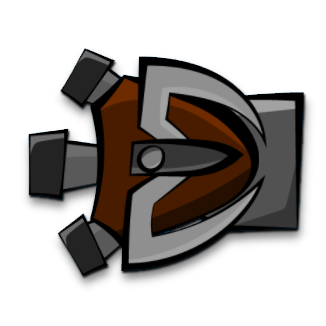
That’s right, I’m talking about you, MegaTurret. I don’t care that you were the first boss we made. You still have three boring attacks, zero theme, and you look like a Space Invader wearing a viking helmet.
A great hook convinces players of two things:
- This boss has a strong identity, and I can use that identity to anticipate its behavior.
- This boss will make me play differently than I have before.
For an excellent example, let’s take a look at the Dark Link battle from Ocarina of Time.
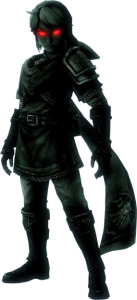 First, the environment puts in your mind the idea of a mirror. Next, you see a character — a twin image of yourself — who mimics your positioning and attacks. This hook allows us to anticipate his abilities. We’ll get a little sting of fear as we imagine being skewered by our own sword, perhaps an authentic viking sword, and a little thrill of hope as we imagine inventing a strategy to get around his seemingly perfect defense. Moreover, a good hook makes things seem more fair. On the face of it, Dark Link is a boss with fast movement, killer damage, and a nearly perfect defense. Only when we understand that he mirrors our own power does this feel like a fair challenge.
First, the environment puts in your mind the idea of a mirror. Next, you see a character — a twin image of yourself — who mimics your positioning and attacks. This hook allows us to anticipate his abilities. We’ll get a little sting of fear as we imagine being skewered by our own sword, perhaps an authentic viking sword, and a little thrill of hope as we imagine inventing a strategy to get around his seemingly perfect defense. Moreover, a good hook makes things seem more fair. On the face of it, Dark Link is a boss with fast movement, killer damage, and a nearly perfect defense. Only when we understand that he mirrors our own power does this feel like a fair challenge.Another fine example comes from Undertale. This example is a dirty, dirty spoiler, so I’ll just give you this video link and let you highlight the text in this quote box if you want to read about it:
Alright, so, Sans’ first attack is the subject here. It’s on a completely new plane of existence compared to anything you’ve seen in the game up to this point. From the instant you see it, you think “[Designer] Toby Fox isn’t playing around any more.” It offers a bold, almost insane promise about what Sans — and Toby’s bosses in general — can do, and boy does Sans ever deliver.
And done with spoilers!
Hook-Master’s Hint: Use the Environment!
As you might imagine, hooks are hard. Every junior varsity novelist knows you should begin with a hook, but how many of them become J.K. Rowling? I don’t have a magic bullet for hook-making, but I have discovered something that makes life a lot easier. When you’re designing a boss, don’t neglect its lair! Building a unique battlefield can be a powerful (and fast!) way to add a hook to an otherwise ordinary villain.
Take Super Mario 64 for example. They stretched Bowser into not one but three boss fights by merely altering the arena in which you fight. They all but copy-pasted their arch-villain, yet every fight asks you to anticipate and overcome new threats, all because of the stage.
Another example comes from our new boss, the Giant Death Ray:
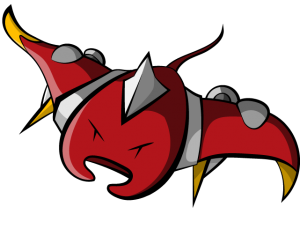 This Zippy McSpeedster puts out only modest firepower, but he makes up for it in speed. As a swift-moving animal with rocket packs, you expect from the first moment that this guy will move like nothing before. And move he does: partway through the fight, you’ll find yourself racing after him as he rockets through the ocean. He’ll dash into a nearby minefield, and suddenly things get tense. His light firepower becomes a devastating threat as you strain to duck through laser shots while navigating around giant naval mines.
This Zippy McSpeedster puts out only modest firepower, but he makes up for it in speed. As a swift-moving animal with rocket packs, you expect from the first moment that this guy will move like nothing before. And move he does: partway through the fight, you’ll find yourself racing after him as he rockets through the ocean. He’ll dash into a nearby minefield, and suddenly things get tense. His light firepower becomes a devastating threat as you strain to duck through laser shots while navigating around giant naval mines.The Ramp
The human mind is an astonishing thing. We go quickly from being excited by a novel experience, to expecting it, to growing tired of it. Even if your hook is astounding, players will quickly adapt to the boss’s repetitive attack patterns. For this reason, bosses — particularly long ones — often benefit by changing things up as the fight wears on.
Now, I could go on and list all the Final Fantasy bosses with form changes or go on about Blizzard’s love of bosses who transform the battlefield, but I think you get the point. When bosses change, we get two major benefits:
- Players stay off-balance, and have to think longer to fully understand the boss.
- The first part of the fight can be easier. We can ease people in while offering challenge down the road.
Ramp-Builder’s Recommendation: Test Boss Evolution with Simple Buff Ramps
In Fingeance, all of our bosses evolve during fights. Usually, we give them new and more flashy attacks as they reach low health. However, we nearly always test bosses using a suite of simple attacks, plus the following ramp:
As the fight progresses (along the X axis, from 0% dead to 100% dead), the boss ramps up its attack speed (along the Y axis, from 50% to 100% of maximum speed). As simple as it is, this small tweak gives fights the feel of a boss growing increasingly desperate to kill the players. If you’re making bosses and you haven’t tried something like this, I strongly encourage you to try it out. It’s as easy to implement as rumble or screen shake, and provides just as much visceral response.
The Turn
This is it. The moment that will linger in your players’ minds forever. We’re entering spoiler territory, so here are some more quote boxes:
Final Fantasy 7 [LINK]. Sephiroth’s Super Nova. This two-minute-long attack shatters game-making conventions, but the raw anticipation of waiting to see what it did made it so worth it.
Hearthstone, Naxxramas Adventure [LINK]. Kel’Thuzad saying “No! Your turn is over! *MY* turn now.” Up until this point, nothing in the game had interfered with turn structure. All of a sudden, Kel’Thuzad showed us that he’s far above obeying the rules.
Chrono Trigger [LINK]. Lavos’ apparent sidekick turning out to be the real Lavos, capable of resurrecting Lavos’ other aspects. Lavos didn’t get a lot of personality in Chrono Trigger, and some was lost in the Japanese-to-English translation. This fight, then, and this move in particular, stood as the only way to determine who Lavos really was. Throughout the game, Lavos appeared to be a big dumb animal, but this attack implies a darker, more malevolent and deceitful persona.
Those are a few from my childhood, and I bet you can think of another half dozen from yours. Here’s the catch though: I don’t think these are perfect. Not by any stretch. My beef? These are all final bosses. Yes, final bosses should be epic, but consider this: by seeding a few high-caliber and ridiculous boss attacks into the early chapters, you can tension and build anticipation for the rest of the game. We’re venturing into very minor spoilers for Darkest Dungeon, but bear with me. The Hag provides a stellar example of an early-game turn.
One of her moves, “Into the Pot!” is the first of its kind in Darkest Dungeon. Here’s it’s description from her wiki page:
During the first turn of the battle, she will use Into the Pot! on one of your heroes. This places them in the Cauldron, where they cannot do anything and take constant HP damage every time you or the Hag makes a move. The Hag has multiple moves per turn.
Simple, but devastating. By this point, you’ve dealt with combat. You’ve dealt with terror and madness. Throughout it all, though, you’ve had control of your characters. Now, you see that a sufficiently juiced-up boss can take even that from you. For me, this boss made a big impact. The fight itself was tough (and thematically clever), but the real stinger came later. After this fight, I was truly excited to see what else Red Hook’s bosses had in store.
In case you don’t know, their final boss might have one of the best turns of all time.
Turn-maker’s Tidbit: Use All the Juice
There are times to hold back on things like screenshake, rumble, screen-darkening, and chromatic aberration. This is not one of them.
Here’s one of the bigger Fingeance attacks right now. Our goal is for this to seem cute by the time we’re done:
Turn-maker’s Tidbit 2: Unfair is your Friend
If you’re a designer, you know that it’s easier to make a bad game than a good one. It’s simply far easier to provoke negative emotions than positive ones. This is where you get to turn that to your advantage. Remember: bosses are bad people. If you give them instant death, mind control, time manipulation, or undodgeable doom rays, it’s all in the game! That open-jawed “what the #%$& just happened” look that you normally try to avoid is now exactly what you want. Provoke a reaction, and go big.
Final Thoughts
I hope you enjoyed today’s look at anticipation in boss design! Beginning designers take note: before any of the above can work, bosses must have ways for players to see their action coming, particularly in action games. This is one of many ways that boss design overlaps with animation, and this video explains the concept perfectly. Once that basic element is in place, you’re free to do anything. Bosses should be your playground to dazzle, to impress, to leave players gasping and wondering where you’ll send them next.
Mad? Sad? Glad as a shad? Tell us all about it on Twitter, Facebook, or IndieDB page.
-

